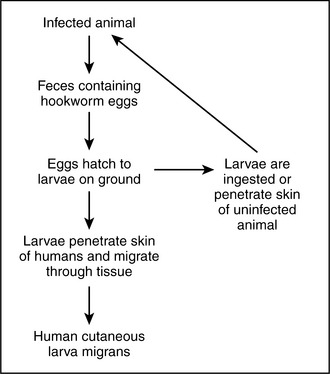HOOKWORMS
Hookworms belong to the phylum Nematoda, which contains worms that are round and unsegmented. Members of this phylum are called nematodes. There are thousands of species of nematodes, but only seven are of zoonotic importance in North America. These are Ancylostoma braziliense, A. caninum, A. tubaeformis, Uncineria stenocephala, Toxocara canis, Toxocara cati, and Baylisascaris procyonis.
T. canis, T. cati, and B. procyonis are nematode parasites that are discussed under roundworms.
TRANSMISSION
Adult hookworms are found attached to the wall of the small intestine. They feed on the host’s blood. During the normal life cycle of hookworms, eggs are passed by adult females in dog or cat feces and hatch as larvae on the ground. In 1 to 3 weeks they become infective larvae. The infective larvae are found in shady, moist, sandy soil. The larvae infect the host either by being ingested or by penetrating the host’s skin (Figure 19).
Larvae that enter the host through minute breaks in the skin migrate to the lungs via the bloodstream. Once in the lungs, they break out of the blood vessels and enter the alveoli, then crawl up the respiratory tree to the trachea, where they cause a mild irritation that makes the host cough. Coughing brings the larvae to the mouth, where they are swallowed and travel to the small intestine, attach to the wall, and mature to adulthood.
If the infective larvae accidentally penetrate the skin of a human through minute breaks, they are unable to penetrate any further than the outer layer of the skin. They cannot penetrate into blood vessels and travel to the lung. Humans are considered atypical or dead-end hosts. Many people are infected by walking barefooted on beaches, where dogs and cats have been allowed to roam freely and contaminate the sand with infected feces.
Stay updated, free articles. Join our Telegram channel

Full access? Get Clinical Tree



